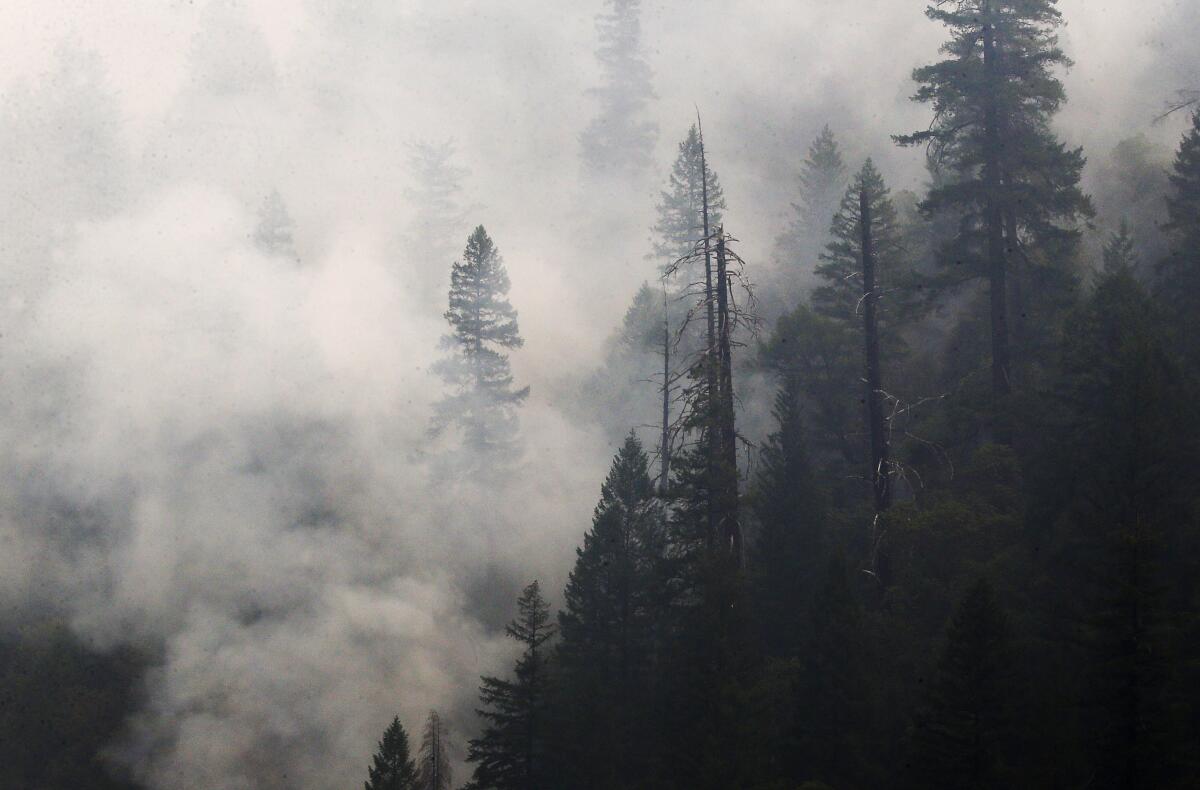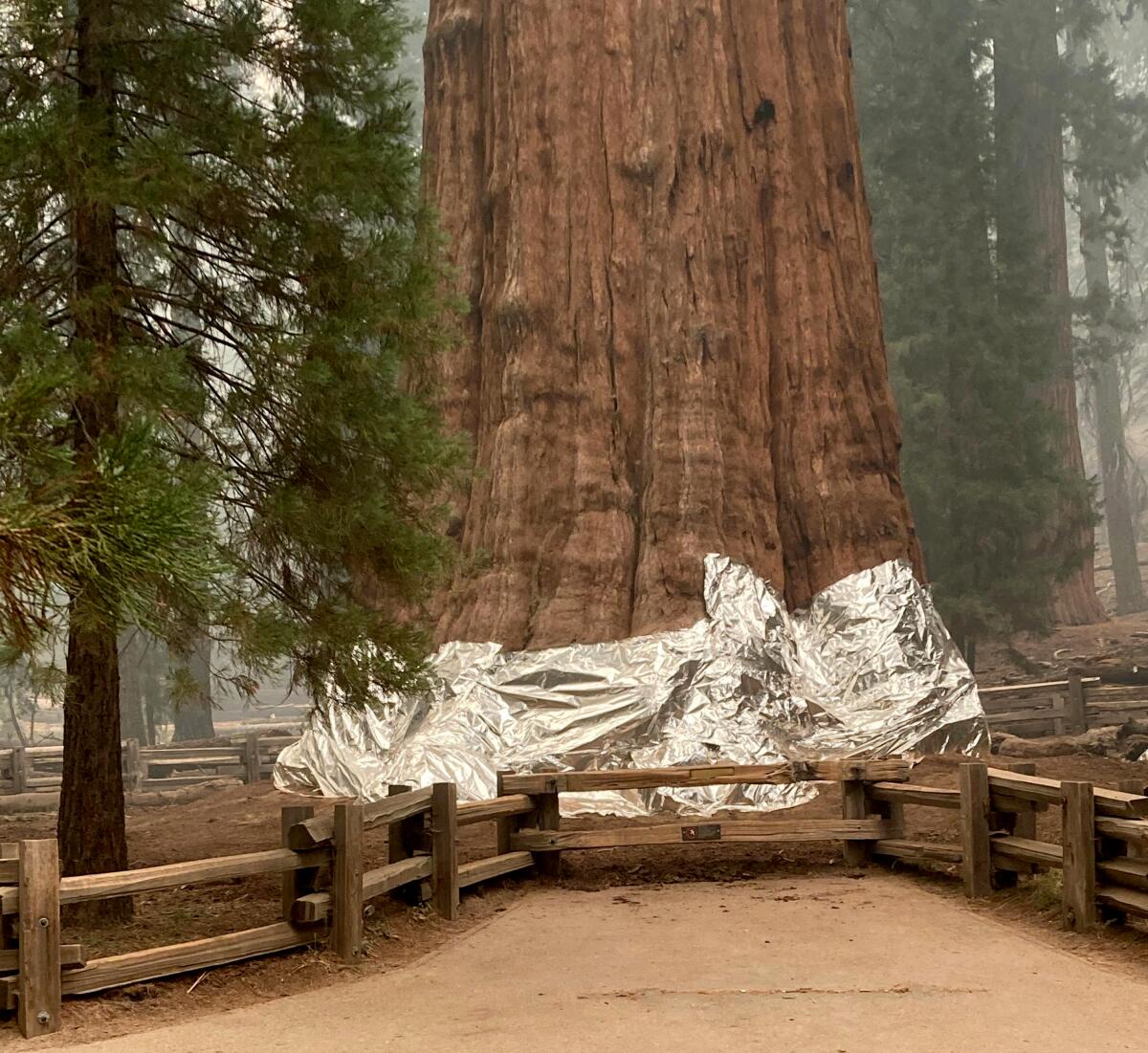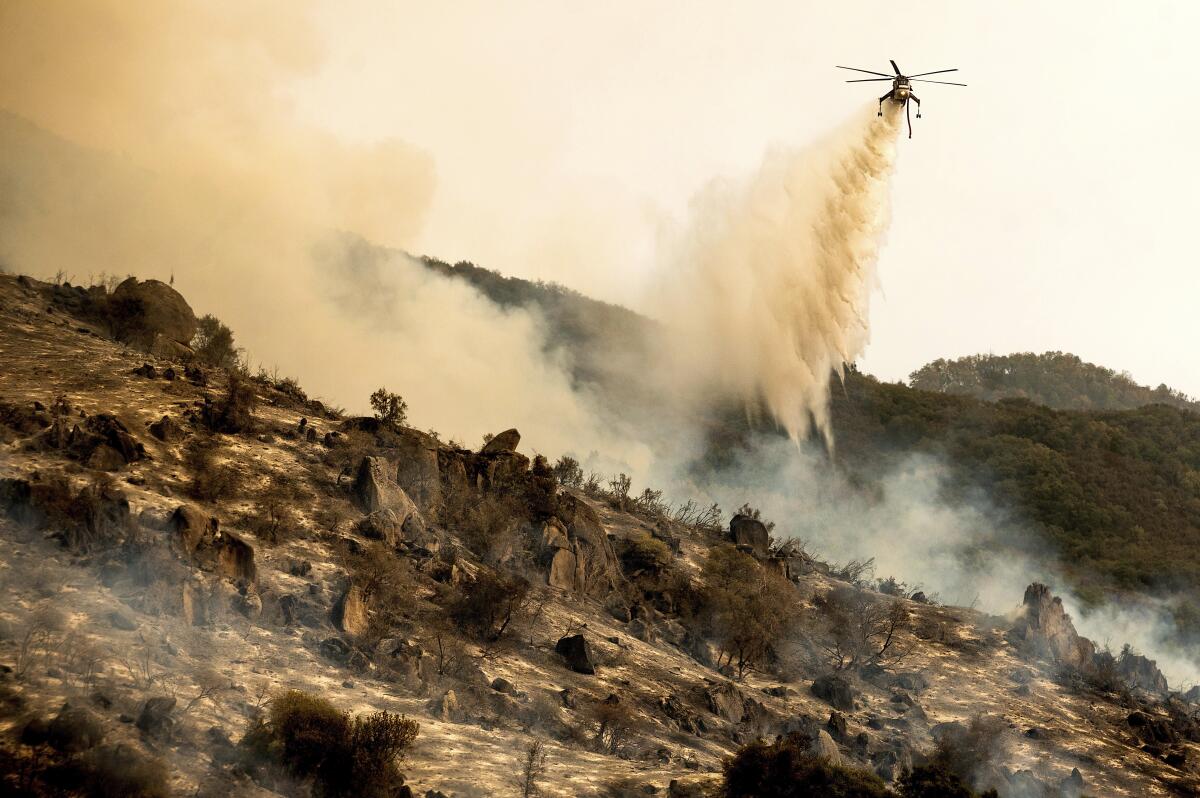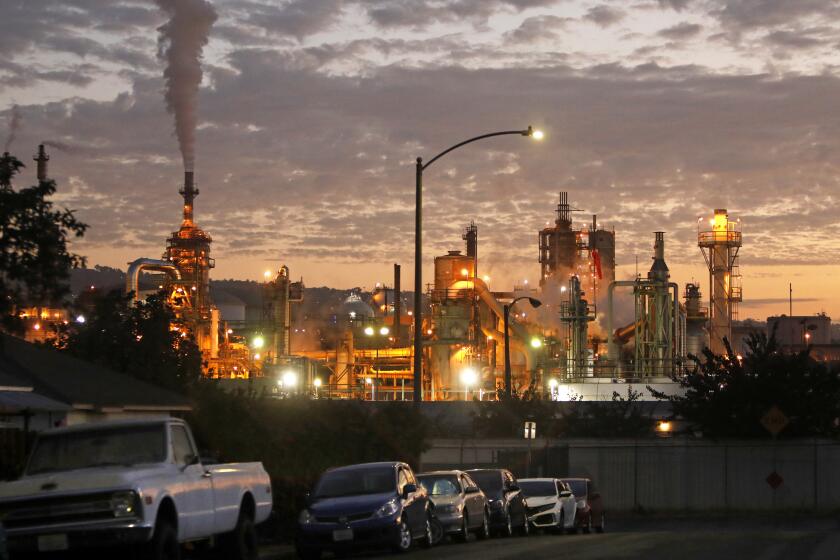As forests go up in smoke, so will California’s climate plan

- Share via
When lightning ignited the bone-dry foothills of the Sierra Nevada last year, forestry crews fanned out across Sequoia National Park to defend an ancient grove of California redwoods from wildfire.
As smoke wafted through a forest of giant sequoias, a dozen crew members surrounded the gargantuan, 36-foot-wide trunk of General Sherman — the world’s largest living tree — and wrapped its base with massive sheets of fire-resistant fabric.
The rescue was a stark acknowledgement that California wildfires are burning faster and hotter than ever before, and now threaten a species that had adapted comfortably to the fires of a previous age.

“I think if you told someone 30 years ago that we were going to do that they would have thought you’re insane. I mean, the bark on the trees is 12 to 18 inches thick,” said Christy Brigham, chief of resources management and science at Sequoia and Kings Canyon National Parks. “But it’s becoming more common as an emergency.”
Now, with recent fires having killed more than 13% of all giant sequoias — a species that grows only in California’s western Sierra — scientists and officials are growing increasingly concerned that the state is nearing a tipping point in which its forests emit more climate-warming carbon dioxide than they absorb.
Citing an ambitious plan to reach carbon neutrality by 2045, the California Air Resources Board is urging state and federal authorities to drastically increase the thinning and treatment of forests that have become dangerously overgrown with flammable vegetation.
While California’s forests and grasslands absorb carbon dioxide during photosynthesis — helping to offset greenhouse gas emissions from human activity — burned forests reduce that storage capacity, or carbon stock.
At the same time, a burning tree will release carbon dioxide. In 2020 alone, California wildfires released more carbon dioxide than all industrial facilities statewide.
“If those forests are going up in smoke, then who’s benefiting from them?” said Pawlok Dass, a climate researcher. “Carbon just goes back into the atmosphere.”
Scientists estimate that about 3 billion metric tons of carbon dioxide are encased in California’s forests, shrubs, grasses and other vegetation. Giant sequoias, because of their supernatural size and longevity, store more carbon dioxide per acre than any tree in the world, and some have been doing so for thousands of years.
But California’s carbon stock is projected to decline over the next two decades as more vegetation dies due to drought, excessive heat and wildfire.
Under a worst-case climate scenario, forests could switch from being a vast repository of carbon to a significant source of emissions by midcentury, Dass said.
Improving forest health is now a significant element of the California Air Resources Board’s draft climate plan.
“A lot of our plan is centered around not losing the carbon stock that we have, because this represents a potential source of emissions that we don’t want to release into the atmosphere,” said Adam Moreno, a lead climate scientist at the board.
Under the plan, state officials are calling for a tenfold increase in land management by 2025, including a drastic increase in prescribed burning — fires that are set intentionally to burn away forest growth. If federal and state crews can treat at least 2.3 million acres of natural lands each year, the state projects that it could help reduce wildfire emissions by 10% over two decades.
However, the air resources board estimates only 250,000 acres are treated each year.
“We’re pushing hard to get to a million acres as a state,” Moreno said. “There’s a lot of implementation challenges around workforce development, permitting, funding for these activities, working with various landowners, working with tribes.”
California is embracing carbon capture and storage technology to fight global warming, but critics say it will only increase oil production.
California hosts a multitude of natural habitats — vast forests of Ponderosa pines and Douglas firs, tangled clusters of chaparral embedded in hillsides, remnants of Pacific wetlands, sere deserts studded with Joshua trees, expansive meadows and coastal prairies.
But forests and shrublands, two habitats most affected by wildfires, contain about 85% of the state’s carbon stock.
Forests, in particular, have endured increasing challenges lately.
As greenhouse gases proliferate with the burning of fossil fuels, climate change has intensified drought and heat waves, leading to higher tree mortality and slower growth rates. Deprived of water, many trees are unable to produce the sap necessary to trap and kill attacking bark beetles.
This mortality follows a centurylong period of heavy forest crowding — a time when forest managers began snuffing out naturally sparked wildfires and Indigenous burning practices were outlawed.
An abundance of dry wood from dead trees and luxuriant blankets of fallen pine needles accumulated over the years, loading forests with flammable tinder.
Such was the case in 2020, when the Castle fire merged with another fire and entered Board Camp, a portion of Sequoia National Park that had not burned in 132 years. The result was flames climbing into giant sequoia canopies more than 100 feet high and the death of 7,500 to 10,600 trees, according to the National Park Service.

“Sequoias really prefer frequent fire, every 10 to 20 years that will burn through … and reduce the amount of litter on the ground,” Brigham said. “What happened in Board Camp is that it basically had no recorded fire history. We’ve suppressed quite a few lightning strikes in that drainage that would have potentially burned through the grove in the past 100 years. So when the Castle fire burned into it in 2020, it just, there was way too much fuel on a steep slope and it just burned incredibly hot.”
California will need to cull some smaller trees to create less dense forests, according to the state climate plan. This process, called forest thinning, is expected to initially result in some carbon losses. But, with more spacing and less competition, it hopes to produce larger, more resilient trees, which will sequester more carbon over time.
But California’s climate plans will mostly hinge on whether forestry managers can increase prescribed burning to ensure there’s less dry, dead plant material that essentially acts as fuel during wildfires.
This July, forestry managers in Sequoia National Park oversaw a controlled burn of 700 acres in a giant sequoia grove.
Though prescribed burns are carried out regularly, it has been difficult to ramp up the pace and scale of burns, according to Brigham, the park science chief. With drier conditions and wildfires seemingly occurring year-round, forestry crews need to be very careful that controlled fires don’t spread beyond what they can manage.
As San Joaquin Valley growers set fire to uprooted vineyards and orchards amid the worsening drought, residents complain of increased air pollution.
Meanwhile, National Park and U.S. Forest Service crews revisit burn scars to survey damage and the extent of tree mortality. But they also survey the charred earth for new life.
Though wildfires have been associated with destruction, they are also the way many trees reproduce.
Giant sequoias, for example, retain seeds inside cones. When heat from fire burns close to them, it opens older cones and releases the seeds, usually only weeks before rains sweep them into the soil.
Oftentimes, after low-intensity fires, forestry crews return and find the forest floor carpeted with thousands of seedlings. Only a few survive to maturity.
But those that do will evolve from tiny green sprouts into the largest organisms on Earth.
Each one with the potential to store hundreds of tons of carbon over its lifetime. Each one an ally for future generations.









